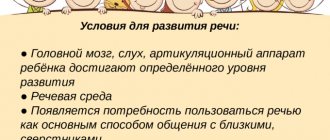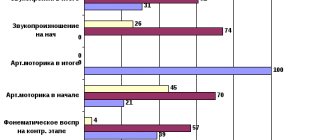Author - A. A. Ostapenko
Difficulties in a child’s speech development very often arise due to the elementary pedagogical illiteracy of parents, kindergarten teachers or school teachers. The experience of conducting seminars and courses for teachers and parents shows that these difficulties arise due to a simple violation of the sequence of mastering speech skills. Some skills are simply forgotten and left out. They are trying to master some of them ahead of time. For example, children are taught to write without being taught to read handwritten texts.
All child’s speech skills are divided into two groups - content and technical. Each content skill is preceded by a technical one, which cannot be skipped or bypassed. This sequence of speech skills is not always obvious to everyone, so it must be clearly defined and visible. Let's look at each skill group separately. Let's start with the content skills and then move on to the technical ones.
Formation of dialogical speech in preschool children
Dialogue is an exchange of remarks between interlocutors. Without dialogical skills, the cognitive process is impossible, and the assimilation of social norms becomes difficult. The development of speech understanding and dialogue building skills are necessarily taught, starting from the younger groups of preschool educational institutions. Various methods are used for this:
- unprepared dialogue;
- reading literature in which characters communicate with each other;
- active, role-playing, theatrical games.
Speech development corner in kindergarten
Conversations with elders are especially important. Dialogues in which adults show interest in the child’s stories best develop communication skills. Unlike communication with peers, during which new verbal formations are practically not learned, regular conversations with educators and parents help to learn effective dialogue.
The kindergarten must not only provide knowledge, but also monitor the compliance of the level of development with existing standards. In addition to external diagnostics, which are carried out annually in all preschool educational institutions at the state level, employees are required to conduct end-to-end monitoring. At the end of each lesson, you should ask students questions and record the level of their answers. If difficulties arise in mastering the rules of dialogue, preschool teachers should use different ways to solve the problem: from additional classes to referral to a speech therapist or psychologist.
Basic ways to develop speech
An important component of communication: dialogical speech of preschoolers
Dialogue is not just an exchange of words. During its construction, information is transferred and new knowledge is acquired. The interlocutors perceive each other’s point of view and learn to respect other people’s opinions. All this forms the basis of competent communication.
If dialogical speech is not developed, the child will be limited in the means of communication. He will not be able to ask a question, ask for help, or answer the teacher’s questions. Interpersonal relationships with parents, classmates, and teachers will suffer greatly.
Dialogue is important not only for building social connections. It underlies communication with teachers and influences the learning of the material. The development of dialogic speech in preschoolers is included in the mandatory preparatory program necessary for entering school.
Additional Information! The norms of the Federal State Educational Standard establish that it is possible to switch to schooling only if you have a competent command of the language.
What skills do preschoolers develop in dialogue?
Researchers argue about what skills develop in dialogue among preschoolers of younger, middle and older ages. Skills may vary depending on age. The following are basic skills for children aged 5 to 7 years.
Development of the prosodic aspect of speech in preschool children
Ability to hear
The child responds to requests, is distracted from his activities to listen to a peer or an adult. He doesn't stop the dialogue mid-sentence or interrupt.
Ability to understand
The preschooler not only listens to the interlocutor, but delves into the meaning of his words. This allows him to choose the right answers, fulfill requests, and continue the dialogue. The child tries to stick to the topic of conversation and not go off into his own thoughts.
Ability to formulate an answer
A preschool education student develops the skill of short and detailed answers. When formulating it, he follows the norms of logic and style, and pays attention to the social status of the interlocutor.
An example of games that help you master the ability to answer
Main types of speech and their characteristics
Below are the main types of speech and their characteristics.
Primary type of speech
Psychology divides human speech activity into two categories: internal and external.
Internal
It is associated with the thinking process, is not formalized orally or in writing, and is not a means of communication. It is figurative, fragmentary, it involves only words that convey the essence of the thought, so the speed of transmission is fast.
Inner speech performs an important preparatory function before the actual voicing of thoughts; thanks to it, “outlines” of statements are compiled.
External
Associated with the process of communication: spoken, written or read. Subtypes of external speech are oral and written.
Written
Formatted using written characters in compliance with grammatical rules. A clear construction of phrases, a thoughtful presentation of thoughts, and coherence of the resulting text are required. Written speech includes both writing itself and reading.
Conversational (dialogue)
A type of oral speech in which a conversation is carried on by two people, using simple phrases and turns of phrase. Does not require detailed expressions and is easily understood by the interlocutor.
Monologue
Refers to oral form, pronounced by one person.
Example: speech by a lecturer, speaker.
A monologue is close to written speech, due to the lack of feedback from the interlocutor. Compliance with the same rules as when writing is required: consistent mental presentation, logic, and the ability to coherently convey information. A monologue is considered a more complex type of speech than dialogue; it involves contact with the audience and requires preparation.
Schematic explanation of speech structure.
Thus, answering the question “What type of speech is primary in the development of a child’s speech activity?”, we can definitely talk about the oral conversational form. It is genetically primary: first, the child masters dialogue (from infancy through interaction with adults). And only then does he learn to organize thoughts in a monologue and writing. To prove the thesis, one can cite the fact that there are still languages and dialects that function only through oral communication. Oral speech is natural in nature, written language is its derivative.
Interesting fact! A large group of people for whom the main form of communication is neither oral nor written speech is the deaf and mute, who do not have hearing or voice from birth, or who have lost them as a result of accidents. For them, the main type of information transfer remains kinetics - gestures, signs. Historically, kinetic speech is the primary type of communication that has existed since ancient times. But, of course, it is not worth comparing the communications of the deaf and dumb with the way of communication of primitive people. The speech of mutes is characterized by complexity and systematization of signs and concepts.
Development of a child’s speech forms in a preschool educational institution
Kindergarten is the place where the development of a child’s personality begins. The professional competence of teachers plays a huge role in this process. The development of coherent speech in the form of constructing dialogues and monologues, laying the prerequisites for writing is one of the primary tasks of a preschool educational institution.
Features of speech development in children of senior preschool age
It is important to understand! This is not a narrowly focused activity, but a whole range of measures taken by specialists, requiring creative solutions. A modern approach to working and teaching both children and teachers themselves is important.
To date, the Federal State Standard of Preschool Education (FSES DO) has been developed and introduced, which identifies the main areas of child development:
- Social and communicative development,
- Cognitive,
- Speech development,
- Artistic and aesthetic,
- Physical.
Educational field "Speech development" according to the Federal State Educational Standard for Education
This standard implies competent work by specialists to help children master the following areas:
- Free expression of thoughts and feelings to establish contact with other children and adults.
- Replenishment of vocabulary, the ability to combine words into sentences, change the form of words, i.e. mastering the grammatical structure.
- Development of creativity, the ability to compose short stories, think through the plots of fairy tales.
- Mastering the stress system, correct pronunciation of sounds, the ability to speak expressively and read poetry.
- Studying letters, word morphology, syntactic rules, preparing for literacy, mastering the basics of writing.
- Gaining experience in reading books.
Speech development in preschool age within the framework of psychology and speech therapy
The development of dialogic speech in preschool children is studied not only within the framework of pedagogical activities. This issue is given attention in abstracts on psychology, speech therapy,
Norms of speech development for preschoolers by age
Teacher speech therapist O. A. Poltavskaya, based on research and diploma work in the field of education and psychology, identifies several periods of speech development. Each has its own standards, on the basis of which a teaching plan in a preschool educational institution is drawn up. Next, we will consider the stages from 9 months to 7 years.
Preparatory
From 9 months the child begins to learn the first words. Speech uses simple sounds: a, m, b, i, u. By 12 months, the vocabulary includes from 2 to 10 words.
Early
Stage from 1 to 3 years. The child begins to actively imitate adults, trying to repeat words after them. At first, most sounds are distorted. The first sentences are completed by 1.5 years, at the same age the vocabulary should already be about 100 pieces. At 2 years of age, the range of pronounced sounds expands significantly: k, g, f, o, and soft consonants appear. Sounds such as soft l, e, th are used from 3 years of age. By the end of the early stage, the preschooler should be able to compose complex sentences using conjunctions.
Preschool
Speech development of preschool children from 3 to 6 years. Vocabulary expands to 3000 units. The sounds are fully mastered: by the age of 4 - s, ts, z, by 5 - hissing, r. Pronunciation deficiencies are considered normal until the age of 7 years. If the incorrect sound of r or other sounds persists by grade 1, you should contact a speech therapist.
Important! Deviations from the listed norms may indicate mental retardation, general delay in speech development, or cerebral palsy.
Speech as part of the child’s overall development
Speech development contributes to overall personal growth. Mastering your native language, first of all, helps to establish communication. Correctly built connections with peers and adults ensure social adaptation and assimilation of social norms. It is no coincidence that children with ODD, who lag behind their peers only in terms of language acquisition, even after successful therapy often show aggression, shyness, and cannot find friends.
The place of speech in the general sensitive development of the child
Oral speech is the basis of mental activity. Coursework and serious scientific research show that children with a rich vocabulary master arithmetic, reading, and writing better. They show more motivation while learning new subjects.
Methods for correcting general speech underdevelopment in preschool children
If insufficient attention is paid to speech development in preschool age, the child will face problems not only when learning at the next level, but also in other areas of life.
The sequence of formation of a child’s meaningful speech skills
This sequence of skills is determined by their degree of complexity. First, simpler speech skills are mastered, and then more complex ones “grow” from them. At the same time, a significant part of the operational composition of writing activities should be formed as part of other activities at the pre-writing stage. Likewise, most grammatical skills should be formed in the depths of activity even before the introduction of grammar into the content of training [2]. That is why we began to consider the problem from the substantive side. The correct sequence for the formation of a child’s meaningful speech skills is as follows.
1. The very first and simplest speech skill that a child develops is the ability to understand spoken speech.
When parents of a one-year-old baby are asked: “How many words does your child know?” - most often they name the approximate number of words that the baby can reproduce. But it is obvious that if this baby has a name that is difficult to pronounce, then he responds to it, even without being able to pronounce it (reproduce it). When a child is told: “Bring the bucket” and he accurately performs this action, it is not at all necessary that he be able to pronounce (accurately reproduce) the word “bring” and the word “bucket”.
Understanding a spoken word is a simpler speech skill than the ability to pronounce the word. And mastering a simpler skill precedes mastering a more complex one. Understanding a spoken word means being able to associate the image of an object (bucket) or an image of an action (bring it) with the word sounding from the mouth of an adult. The connection “image of an object/action + sounding word” forms the child’s first and simplest speech skill.
2. The second speech skill consists of a well-developed ability to coherently reproduce a spoken text.
This skill is more complex than the first, and it is called speaking. The number of words a child understands is many times greater than the number of words he can pronounce. Understanding the sound of a word is significantly ahead of speaking. This is obvious and does not require proof.
3. The third speech skill is the skill of reading text depicted in printed letters.
Here we will not dwell long on approaches to teaching reading, since this has been described many times. We focus only on the seemingly obvious statement that the ability to read is the ability to understand graphic text (printed or handwritten). Alas, the experience of working with kindergarten teachers and primary school teachers in advanced training courses convinces us that by the ability to read they most often understand something else (the ability to merge letters and sounds into syllables, the ability to combine syllables into words, the ability to articulate and etc.). The third speech skill consists of a well-developed ability to understand the printed word, printed text, which means being able to associate the image of an object/action not only with the word coming from the mouth of an adult, but with its graphically depicted printed image. The triple connection “image of an object/action + sound word + printed word” forms the child’s third speech skill - reading printed texts
4. The fourth speech skill is coherent reproduction of printed text.
Acquiring this skill cannot in any way be ahead of reading printed text. Writing in block letters or reproducing (typing) text on the keyboard that the child does not understand (does not read) is pointless. But it is quite obvious that this requires some additional motor skills combined with the skill of reading as understanding printed text. And this is already a rather complex synthetic skill, and therefore it is only fourth in the series of speech skills.
The Russian language has two types of graphic representation - in the form of printed graphics and in the form of handwritten graphics associated with calligraphy. And this requires the development of two additional speech skills - the ability to read handwritten texts and the ability to reproduce handwritten text in calligraphy. In many European countries, partly in the USA and Canada, for decades now they have abandoned the need to teach children to use cursive scripts and to teach children calligraphy. In these countries, children only “type” and do not write texts in handwritten letters. In our opinion, this unusually impoverishes the culture of the language and emasculates the aesthetic educational component of the language1. Replacing handwritten albums and notebooks with poems and wishes, which were a significant part of the girl’s personal life, with personal pages on social networks not only destroyed the mystery and enigma, but also primitivized the perception of the text, both meaningfully and graphically. The sophistication of monograms in albums migrated to the primitivism of graffiti on fences. The disappearance of calligraphy in countries that write in the Latin alphabet is also evident in the teaching of foreign languages in our school. In teaching calligraphy in the Russian language, this has so far been expressed in a tendency to simplify the graphics of letters in the direction of cursive writing, which has not primitivized the Cyrillic writing as much as the Latin alphabet.
5. It is quite obvious that before teaching a child to master copybooks and write calligraphy, it is necessary to teach him to read handwritten texts.
The traditional method of primary education simply omits an entire stage of a child’s speech development. Even if this stage is not the most cumbersome, it should be there. But in schools we will not find books with handwritten texts. Nobody simply publishes them, supposedly because they are unnecessary.
The fifth speech skill, associated with mastering the reading of handwritten texts, is necessary for mastering calligraphic writing. Skipping this stage or skipping over it in the future will seriously deform, first of all, the aesthetic side of calligraphy. Lack of rich linguistic experience of seeing beautiful calligraphic handwritten texts is one of the main reasons for poor handwriting.
In the experience of working using the technology of A. M. Kushnir, children of the 1st grade have several books with ready-made handwritten texts (a book of fairy tales by A. S. Pushkin, the books “Our Songs”, “Grandmother’s Songs”, “Victory Day”), which often incorrectly called copybooks. Understanding a handwritten word means being able to associate the image of an object/action not only with the word coming from the mouth of an adult and its graphically depicted printed image, but also with the handwritten calligraphic word. The quadruple connection “image of an object/action + sounding word + printed word + handwritten word” forms the child’s fifth speech skill - reading handwritten texts.
6. Based on the ability to read handwritten texts, the sixth skill is formed - calligraphic writing as the ability to graphically reproduce handwritten texts
7. Based on these six stages, the seventh skill is formed - competent writing.
This is the general algorithm for moving from simple to complex speech skills. Neglecting any stage leads to defects in the child’s speech development. Let's depict it as a chain of sequential speech skills:
1) the ability to understand spoken text → 2) the ability to coherently reproduce spoken text → 3) the ability to read printed text → 4) the ability to reproduce printed text → 5) the ability to read handwritten text → 6) the ability to reproduce handwritten text → 7) the ability to write correctly.
Speech requirements for kindergarten teachers
High demands are placed on the speech of preschool teachers. The teacher must not only correctly express his thoughts and follow literary norms, but also be able to build a dialogue in accordance with the level of development of the students. Basic requirements that an employee’s oral speech must meet:
- Right. Following the norms of the language.
- Accuracy. Using words in the correct meaning.
- Logic. Proper use of intratextual communication.
- Purity. Absence of non-literary words and expressions.
- Expressiveness. Mastery of intonation, pitch, strength and volume of voice to attract students' attention.
- Wealth. Imagery of speech, wide vocabulary.
- Relevance. Correspondence of speech style to the current situation.
Teachers' council dedicated to teaching dialogue in preschool educational institutions
If there are deviations from the listed requirements, the teacher should improve his speech through self-education or advanced training. To eliminate errors, presentations for teaching councils are also used, containing control tests and instructions for educators.
Methods for examining the speech of preschool children
Diagnosis of speech development in children of early and preschool age is carried out according to the following parameters:
- Child's dictionary.
- Sound culture of speech.
- Grammar.
- Development of coherent speech.
Used literature on the topic: Gribova O. E., Bessonova T. P. “Didactic material on examining children’s speech”
Specialists should evaluate a child's skills only using appropriate diagnostic materials that help them objectively approach the assessment of children's speech abilities. To select instruments and examination technologies, it is recommended to use the methodological literature of Gribov and Bessonov “Didactic material for examining children’s speech.”
It is presented in three directions:
- "Lexicon",
- "Grammar structure"
- “Sound Side” part 1, part 2.
Survey of the sound culture of children's speech
The concept of “sound side” refers to sound pronunciation. Diagnosis of the sound culture of speech of preschoolers should be carried out by a speech therapist twice a year: in the fall - when drawing up a plan for correctional work, and in the spring - when summing up the results.
Important! During the study of sound pronunciations, the teacher should note the following indicators: which sounds were pronounced correctly, whether there are violations of the syllabic structure of words, whether the child can regulate the strength of the voice, tempo, whether there were any omissions in sound pronunciation correction, active or passive speech activity.
Components of speech
Speech can be divided into two components: situational and contextual. When expressing his thoughts or describing a situation, a person must construct a monologue so that the listener understands what the conversation is about. At first, children are unable to describe the situation without specifying specific actions. It is difficult for an adult, listening to a story, to understand what the conversation is about without knowing the situation. Thus, situational coherent speech of preschoolers is formed first. At the same time, the presence of a contextual component cannot be completely excluded, since such moments of speech are always interconnected.






